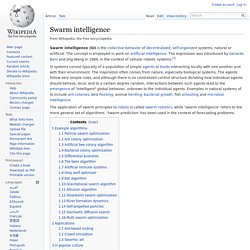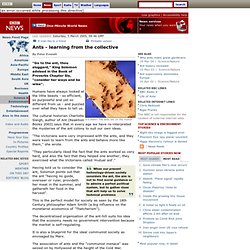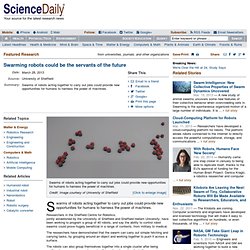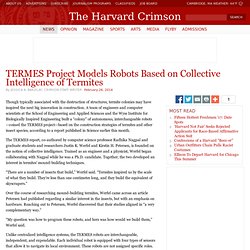

Swarm intelligence. Swarm intelligence (SI) is the collective behavior of decentralized, self-organized systems, natural or artificial.

The concept is employed in work on artificial intelligence. The expression was introduced by Gerardo Beni and Jing Wang in 1989, in the context of cellular robotic systems.[1] Ants - learning from the collective. "Go to the ant, thou sluggard," King Solomon advised in the Book of Proverbs Chapter Six, "consider her ways and be wise".

Humans have always looked at the little beasts - so efficient, so purposeful and yet so different from us - and puzzled over what they have to tell us. The cultural historian Charlotte Sleigh, author of Ant (Reaktion Books 2003) says that in every age we have re-interpreted the mysteries of the ant colony to suit our own ideas. "The Victorians were very impressed with the ants, and they were keen to learn from the ants and behave more like them," she wrote.
Swarm Intelligence: From Natural to Artificial Systems. The mystery of collective intelligence - Energy Dimension. Birds in flocks make turns as a collective.

Ants build, supply, and defend their burrows. How does a group make better decisions than any one of its members? The New York Times > Science > Image > Simulating Swarm Intelligence. The mystery of collective intelligence. Nanocomputers and Swarm Intelligence. Jean-Baptiste Waldner Publication Date: February 2008 Hardback 304 pp. eBooks Description.

Swarm Robotics: The Future of Collective Intelligence. A collective form of intelligence Swarm robotics is a new approach to the organisation of miniature multirobot systems.

It has emerged from the Artificial Intelligence field and from biological studies of swarm behaviour frequently found in nature. This type of behaviour applies a collective form of intelligence, more commonly known as the “hive mind” principle to organise individual members within the group for a purpose. Swarming robots could be the servants of the future. Swarms of robots acting together to carry out jobs could provide new opportunities for humans to harness the power of machines.

Researchers in the Sheffield Centre for Robotics, jointly established by the University of Sheffield and Sheffield Hallam University, have been working to program a group of 40 robots, and say the ability to control robot swarms could prove hugely beneficial in a range of contexts, from military to medical. The researchers have demonstrated that the swarm can carry out simple fetching and carrying tasks, by grouping around an object and working together to push it across a surface. TERMES Project Models Robots Based on Collective Intelligence of Termites. Though typically associated with the destruction of structures, termite colonies may have inspired the next big innovation in construction.

A team of engineers and computer scientists at the School of Engineering and Applied Sciences and the Wyss Institute for Biologically Inspired Engineering built a “colony” of autonomous, interchangeable robots—coined the TERMES project—based on the construction strategies of termites and other insect species, according to a report published in Science earlier this month. The TERMES report, co-authored by computer science professor Radhika Nagpal and graduate students and researchers Justin K. Werfel and Kirstin H. A clustering algorithm based on swarm intelligence. Multi-swarm Problem Solving in Networks.
Swarm - Communities and Networks Connection. Swarm Theory. I used to think ants knew what they were doing.

The ones marching across my kitchen counter looked so confident, I just figured they had a plan, knew where they were going and what needed to be done. How else could ants organize highways, build elaborate nests, stage epic raids, and do all the other things ants do? Turns out I was wrong. Ants aren't clever little engineers, architects, or warriors after all—at least not as individuals. When it comes to deciding what to do next, most ants don't have a clue. The Certain Future Of (Drone) Swarm Intelligence. By Jan Wellmann, HoneyColony Just moments before his life ended April 10, 1955, Pierre Teilhard de Chardin was having a lively discussion with his cousin on Park Avenue in New York.

Most likely they were discussing his favorite subject, the “Omega Point,” his theory on the destiny of evolution. Pierre was a French philosopher, Jesuit priest, paleontologist, geologist, physics and chemistry teacher, botanist, and zoologist. Let’s just say he was well-versed. The Birth of Swarm Intelligence : Remarkk! Twitter is the human swarm: an always-on, open, global and decentralized conversation.

Twitter has undergone a phase change as a communications tool, and we see its effects globally, from news of the attacks in Mumbai to Toronto’s tech scene. Something new is emerging, something very powerful: Twitter is becoming a platform for collective action. Eric Bonabeau, Marco Dorigo and Guy Theraulaz: Swarm Intelligence - From Natural to Artificial Systems. This chapter is a little bit different than the others. There are no simulation models given that try to explain the phenomena. The authors begin with the statement that the examination of co-operative transport is not really interesting for research on swarm intelligence but must be dealt with because it is generally seen as an important benchmark for robotic systems. Observations in nature or experiments with real ants show that co-operative prey retrieval is not yet fully understood. Nonetheless, there are some studies concerning recruitment of nest mates (the process in which a single worker determines that it cannot retrieve prey without help), positioning around the item and object alignment carried out by the ants and the actual transport with its adaptation to external perturbations like obstacles.
The authors describe a robotic implementation of co-operative transport that replaces other formalised models. Swarmwise — The Tactical Manual to Changing the World Chapter 1. "In a Swarm, nobody gets to tell anybody else what to do. (People can take on roles and deliverables voluntarily, though.) " Falkenvinge has boots on the ground experience building successful activist organizations and with this book he promises to share this knowledge widely. What follows is Chapter 1. Somewhere today, a loose-knit group of activists who are having fun is dropkicking a rich, established organization so hard they are making heads spin. The Swarm Lab @ NJIT - Simon Garnier - Swarm Intelligence in Natural and Artificial Systems. One hundred Harvard Kilobots swarm together. One hundred Kilobots move towards a light source Image Gallery (7 images) Robots by the dozen are prohibitively expensive, so actually testing how large swarms would work together is often limited to computer simulations.
That's where Harvard's Kilobots are beginning to bear fruit – at a cost of US$14 each in batches of a thousand, they're a tenth the cost of their cheapest competitor. At such bargain-basement prices, Michael Rubenstein, Christian Ahler, and Radhika Nagpal at the Self-Organizing Systems Research Group have begun to build their own little robot army. View all A single Kilobot communicates with its neighbors by pulsing its infrared LED, which shines and reflects off the floor beneath it. Back in 2011 when the project first came to our attention, we saw how 29 Kilobots could demonstrate some interesting collective behaviors. 100 Kilobots move towards a light source Collective transport with 100 Kilobots. Self-organizing Systems Research Group. A Low Cost Scalable Robot System for Demonstrating Collective Behaviors Purchase some from K-Team: K-Team Corp is making Kilobots available for purchase, starting now!
See the K-Team Flier and K-Team homepage. Robots, Collective Intelligence, and Participatory Governance: Nikolaos Mavridis at TEDxCarthage. The Swarm intelligence. A new theory, which I found extremely interesting, is referring to Swarm intelligence (SI) defined as the collective behaviour of decentralized, self-organized systems, natural or artificial. The concept is employed in work on artificial intelligence. The expression was introduced by Gerardo Beni and Jing Wang in 1989, in the context of cellular robotic systems.
SI systems are typically made up of a population of simple agents interacting locally with one another and with their environment. The inspiration often comes from nature, especially biological systems. Swarm behaviour. Couzin Lab – Collective Animal Behavior. How swarms build cognitive maps. The Power of Swarms Can Help Us Fight Cancer, Understand the Brain, and Predict the Future. The first thing to hit Iain Couzin when he walked into the Oxford lab where he kept his locusts was the smell, like a stale barn full of old hay. The second, third, and fourth things to hit him were locusts. The insects frequently escaped their cages and careened into the faces of scientists and lab techs. Hive-mind solves tasks using Google Glass ant game - tech - 05 August 2013.
GOOGLE Glass could soon be used for more than just snapping pics of your lunchtime sandwich. Swarm Creativity: Competitive Advantage through Collaborative Innovation ... - Peter A. Gloor - Google Livres. The Smart Swarm: How Understanding Flocks, Schools, and Colonies Can Make Us ... - Peter Miller - Google Books. Curation, Swarms, and Conscience. Here's a course of links and comments from this week, clustered around current trends in media curation and consumption: is a nifty site that seems to have been mothballed about a year ago, but is a significant example of the powerful Magnify engine for video content aggregation, curation, and community interaction in this (ecosocial) domain.
I will waggishly opine that a major handicap of the environment is its lack of intuitive structuring and user engagement. Existing collections are dispersed and introspective, providing generally low 'content content' for casual browsers...really a step down from the generic Youtube experience, lacking broad community filtration and 'hive mind' potency. contains some analysis of 'swarm behavior' in the context of media consumption and distribution. Two laudable sites working to catalyze glocal (globally localized) action addressing climate threats: and by seeding ideas into a community and using positive feedback loops to drive convergence.
Nano Quadrotors: Quadricopters with Artificial Swarm Intelligence by GRASP Lab & KMel Robotics. Swarm Intelligence: Are digital ants the answer to malware? Modeling Nature may be the best way to solve the malware problem. Learn how digital ants could be the answer. Swarm intelligence. Swarm Smarts. Using ants and other social insects as models, computer scientists have created software agents that cooperate to solve complex problems, such as the rerouting of traffic in a busy telecom network. Insects that live in colonies—ants, bees, wasps, termites—have long fascinated everyone from naturalists to artists.
Collective intelligence: Ants and brain's neurons. CONTACT: Stanford University News Service (415) 723-2558. Fundamentals of Computational Swarm Intelligence - Home. [1306.3018] Second Order Swarm Intelligence. Swarmworks. A theoretical framework for swarms of GRN-controlled agents which display adaptive tissue-like organisation. Collective Intelligence in Social Insects. Les secrets de la jungle d'Amérique - La société des araignées. The biological principles of swarm intelligence.